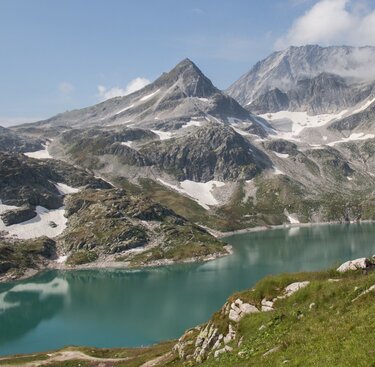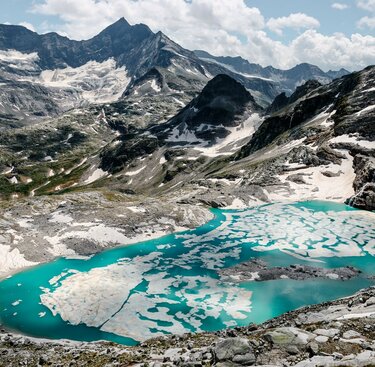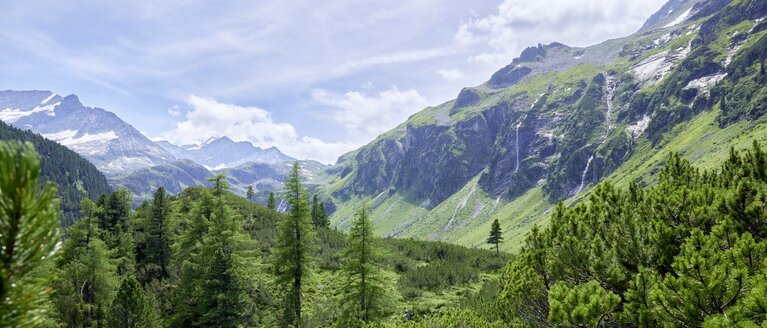Stubachtal
Uttendorf
Peaks and crossings
- Stubacher Sonnblick (3.088 m)
- Granatspitze (3.086 m)
- Medelzkopf (2.761 m)
- Johannisberg (3.453 m)
- Hohe Riffl (3.338 m)
- Hocheiser (3.206 m)
- via Granatscharte (2.970 m) to the Karl-Fürst-Hütte (2.629 m, unmanaged)
- via Kalser Tauern (2.515 m) to the Kalser Tauernhaus
- via Obere Ödenwinkelscharte (3.228 m) to the Oberwalderhütte
- via Kapruner Törl (2.639 m) to the Stausee Mooserboden, Kaprunertal
Valley of Lakes - Glacier Realm

Valley of Lakes - Glacier Realm
The name Stubach comes from "spraying water". Only the innermost part of Stubachtal is remarkably scenic as such and abundant with mountain lakes thanks to the energy industry and tourism Part of the national park. Weissee, Tauernmoossee, Grünsee and Enzingerboden are dammed and partly stocked with fish. But there are still lakes not tampered with such as Karsee, Schafkopfsee, the Kleineiser lakes, Salzplattensee and many more. Wurfbach and Ödbach streams (in the western tributary valley Dorfer Öd) are fed by numerous glaciers. Trace of erstwhile glaciation such as the kettle basins at Grünsee and Enzingerboden lakes can still be clearly seen.
Fantastic forests
In Stubachtal, spruce forest prevails with larch trees and Swiss pine at higher altitude. The entrance to the valley features a particularly beautiful mixed deciduous forest, a natural landmark with ash, harewood, wych elm, willow and grey alder. The very rare giant bellflower also grows here. A special natural landmark is the Wiegenwald forest, a unique woodland and moorland north-west of the Enzingerboden at 1,400 to 1,800 m above sea level. An ice-age moraine here is populated with spruce, larch and Swiss pine. The glacial trough is home to circular moors with beautiful vegetation and interesting fauna.
Of animal wayfarers and giant crystals
Every year, countless butterflies and birds move through Stubachtal across the main alpine ridge. These include butterflies such as the admiral or painted lady, or birds like swallows and larks. Some species migrate at day, others at night. Not a migrant but an exceptionally rare breeding bird found in the area is the red-spotted bluethroat. The area around the Hohe Riffl is known as source of minerals, including apatite, magnetite, diopside and others. Giant rock crystals have also been retrieved from the northface of the Eiskögele (approx. 3,000 m altitude) with the largest weighing in at 618 kg. Today they can be seen in the 'Haus der Natur' - Nature Museum in Salzburg.
Glacial nature trails Ödenwinkel and Sonnblickkees

Glacial nature trails Ödenwinkel and Sonnblickkees
These family-friendly designed high alpine trails lead across the forelands of the Ödenwinkel and Sonnblickkees to the snouts of both glaciers. In addition to diverse alpine flora, mountain hikers can marvel at and study this ice-age wealth of forms. The first trail leads across the Schafbühel hills to the Eisbodenlacke small salt water lake and from there through terrain which has been ice-free since the middle of last century to the glacier terminus of the Ödenwinkelkees. The second leads around Tauernmoossee lake to the Sonnblickkees glacier.
Walking time: approx. 2 – 3 hrs. from Rudolfshütte alpine hotel.
Excursion to Wiegenwald forest
From the valley station of the Weißseegletscher Cable Car, National Park Rangers take you through the primeval Wiegenwald up to the Schwarze Lacke. Beautiful bog pools along the way invite you to linger, and indulging in the numerous blueberries along the path fortifies you for the rest of the tour.
Walking time: approx. 3.5 hours


